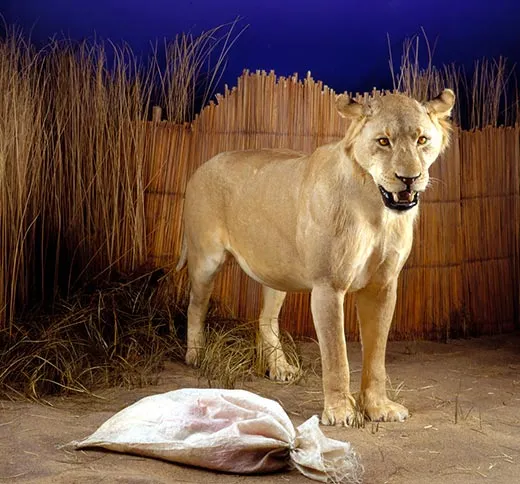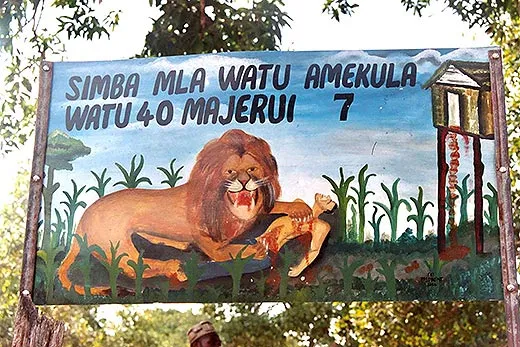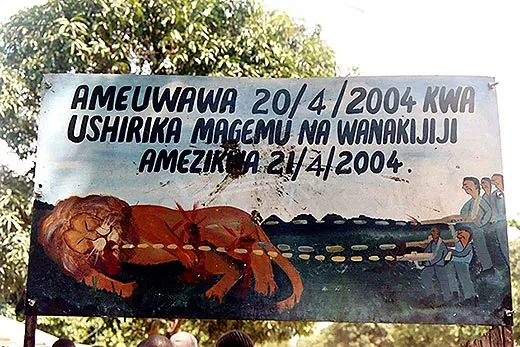The Most Ferocious Man-Eating Lions
Africa’s lions may usually prey on zebras or giraffes, but they also attack humans, with some lions responsible for over 50 deaths
/https://tf-cmsv2-smithsonianmag-media.s3.amazonaws.com/filer/memorial-to-death-of-man-eating-lion-631.jpg)
In encounters with the king of beasts, an unarmed person is “one of the most helpless creatures,” notes Charles Guggisberg in Simba: the Life of the Lion. “Man cannot run as fast as a zebra or a gazelle, he has not the horns of the sable antelope or the tusks of the warthog, and he cannot deal terrific blows like the giraffe.” People are, in other words, easy pickings. Even though Africa’s lion populations have been drastically reduced in the past decades, lions still regularly eat people; it’s not uncommon for them to kill more than 100 people a year in Tanzania alone.
Many man-eaters are wounded or old; some have been deprived of natural prey sources; others may simply have developed a fondness for human flesh. Most are nameless, but a few of the most notorious have been rather colorfully christened: Namvelieza, or The Cunning One, killed 43 people near Kasawa, Zambia. Tanzania’s Paper Lion got his name because he seemed to drift from victim to victim randomly, like a scrap of paper floating in the breeze.
This list of the most famous man-eaters includes mostly males, but females are actually responsible for more killings, according to University of Minnesota lion expert Craig Packer. However, lionesses tend to eat people in isolated instances, then return to their normal diet, while males “are more likely to become recidivists,” Packer says. The worst-case scenario, he says, is when a whole pride of males and females starts feeding on people: these lions are the most “persistent” threat to their human neighbors.
Chiengi Charlie
This man-eater—missing half his tail and so light-colored that he was also known as “the White Lion”—haunted Chiengi, the British post on the border of what was then Northern Rhodesia (now Zambia), in 1909. “In the district in which he carried on his nefarious practices Charlie (became) a celebrity, almost an institution,” according to one account. “He was alluded to with the almost affectionate familiarity with which some people speak of the devil.” He eventually teamed up with two other males to feed on the inhabitants of several villages. Charlie and his partners reportedly ate 90 people, including the servant of a hunter sent to destroy him. He eluded all manner of traps and the best marksmen in the country (though one village woman managed to beat him off with a firebrand as he clawed through the mud wall of her hut.) He was finally shot in a gun trap.
Osama
Osama terrorized Rufiji, Tanzania, from 2002 to 2004; he was accused of killing more than 50 people from eight villages. Part of a pride of males and females, Osama likely didn’t kill alone, but he was the lion villagers singled out to star in billboard-size depictions of the bloody deeds (according to Tanzanian lion scientist Dennis Ikanda, the lion was named after Osama bin Laden, whose terrorist attacks made headlines even in rural Tanzania.) Osama was just 3 1/2 years old when game scouts shot him in April of 2004. Some have blamed his eating habits on a large abscess on one of his molars, but, according to Packer, whose research team studied the case, plenty of man-eaters have perfect teeth. Osama “probably got started when his mother started eating people,” Packer says.
Msoro Monty
Though historically rich in wild game, the Luangwa River Valley in eastern Zambia has produced a series of fearsome man-eaters. In 1929, one began stalking victims near the Msoro Mission, which furnished his alliterative nickname. “Msoro Monty” never lost his knack for sniffing out traps. After killing a large number of people, he disappeared without a trace.
Lion of Mfuwe
This cat terrorized Zambia’s Luangwa River Valley—near Msoro Monty’s old stamping grounds—in 1991. After killing at least six people, the lion strutted through the center of a village, reportedly carrying a laundry bag that had belonged to one of his victims. A California man on safari, after waiting in a hunting blind for 20 nights, later shot and killed him. The lion was more than ten feet long and, like the famous Tsavo lions, totally maneless. His body is on display at Chicago’s Field Museum.
Tsavo Lions
Hollywood darlings and arguably the most famous of the man-eaters, the Tsavo lions have been the subject of several movies—including Bwana Devil (1952) and The Ghost and the Darkness (1996)—and many books. The pair of males was accused of devouring some 140 workers along Kenya’s Tsavo River, where crews were building a railroad bridge in 1898. Hundreds of workers fled, halting construction; the project’s chief engineer finally hunted down both lions, and the bridge was completed in 1899. Recent analysis of the lions’ hair and bones suggest that the lions likely ate only about 35 people.
The Man-Eaters of Njombe
The most prolific of the man-eaters, this pride of 15 claimed hundreds of lives—perhaps as many as 1,500—of lives between 1932 and 1947 in southern Tanzania. “The renowned man-eaters of Tsavo were very small fry compared to what these proved to be,” wrote George Rushby, the British game warden charged with stopping them. Prior to the pride’s bloody spree, the colonial government had reduced the numbers of prey animals in the area in an effort to control a rinderpest outbreak that was destroying cattle herds. The hungry lions quickly settled on human flesh as a substitute. Unlike most lions, the Njombe pride did its killing in the afternoon, using the night hours to travel as far as 15 or 20 miles to an unsuspecting village. Rushby believed that the cats actually used a relay system to drag bodies into the safety of the bush. He finally hunted down and shot the lions.


